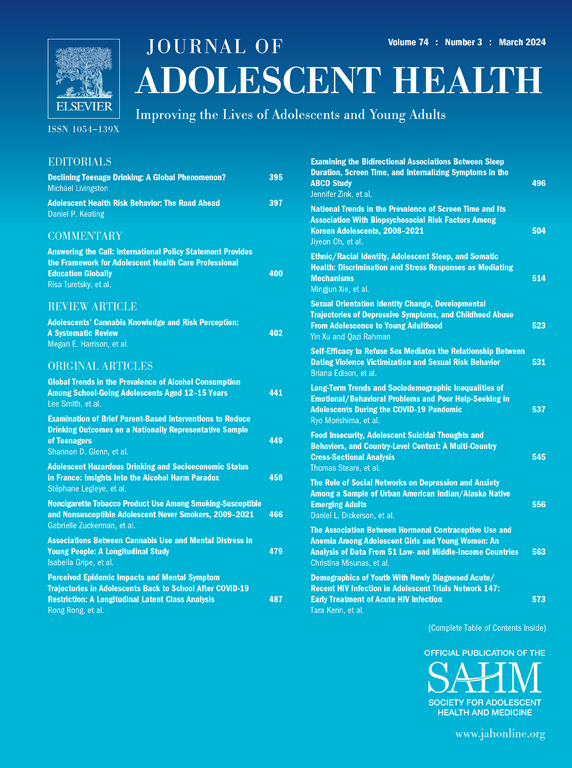Longitudinal Behavioral Transitions in Adolescent Electronic Nicotine Delivery Systems Use: Markov Multistate Transition Model
IF 5.5
2区 医学
Q1 PEDIATRICS
引用次数: 0
Abstract
Purpose
Many prior studies on adolescent electronic nicotine delivery systems (ENDS) did not differentiate regular users from light users or experimenters. This study was conducted to investigate the longitudinal behavioral transitions among adolescent ENDS users.
Methods
Data were drawn from Waves 2, 3, 4, 4.5, and 5 (October 2014–November 2019) of the Population Assessment of Tobacco and Health (PATH) Study and analyzed in 2023. A total of 894 participants (1) who reported at least one day of ENDS use within the past 30 days at any of the waves; and (2) who had ENDS use data on at least 2 different waves were retained in the final analysis sample (N = 894). Markov multistate models were fitted to estimate transition hazard rates between experimental use, nonfrequent use, frequent use, and no use.
Results
Whereas experimental use grew from 2.6% at Wave 2 to 15.4% at Wave 5, nonfrequent use grew from 2.9% to 18.9%, and frequent use grew from 0.3% to 18.8%. Sixty-five percent of experimental use reverted to no use whereas 20% of experimental use progressed to either nonfrequent (12%) or frequent ENDS use (8%) in a year. Once ENDS use is initiated, the percentage progressing to frequent ENDS use jumped to 19% while 20% staying as nonfrequent use in a year. The average past 30-day use frequency of those who reported “fairly regular” use increased over time (6.2 days at Wave 2 to 15.7 days at Wave 5).
Discussion
These findings demonstrate worrisome tendency of increasing intensity of ENDS use in today's adolescents.
青少年电子尼古丁传递系统使用的纵向行为转变:马尔可夫多状态转变模型。
目的:许多关于青少年电子尼古丁传递系统(ENDS)的先前研究没有区分常规使用者、轻度使用者或实验者。本研究旨在探讨青少年终端用户的纵向行为转变。方法:数据取自烟草与健康人口评估(PATH)研究的第2、3、4、4.5和5期(2014年10月- 2019年11月),并于2023年进行分析。共有894名参与者(1)报告在过去30天内至少有一天在任何一波使用ENDS;(2)在最终分析样本中保留了至少2个不同波的终端使用数据(N = 894)。拟合马尔可夫多状态模型来估计实验使用、不经常使用、经常使用和不使用之间的过渡危险率。结果:实验用药从第二波的2.6%增长到第五波的15.4%,不频繁用药从2.9%增长到18.9%,频繁用药从0.3%增长到18.8%。65%的实验使用者在一年内恢复为不使用,而20%的实验使用者在一年内发展为不频繁(12%)或频繁使用终端(8%)。一旦开始使用终端,在一年内,频繁使用终端的比例跃升至19%,而不频繁使用的比例为20%。在过去的30天里,那些报告“相当规律”使用ENDS的人的平均使用频率随着时间的推移而增加(第2波为6.2天,第5波为15.7天)。讨论:这些发现表明,在当今的青少年中,ENDS使用强度的增加趋势令人担忧。
本文章由计算机程序翻译,如有差异,请以英文原文为准。
求助全文
约1分钟内获得全文
求助全文
来源期刊

Journal of Adolescent Health
医学-公共卫生、环境卫生与职业卫生
CiteScore
10.40
自引率
3.90%
发文量
526
审稿时长
46 days
期刊介绍:
The Journal of Adolescent Health is a scientific publication dedicated to enhancing the health and well-being of adolescents and young adults. Our Journal covers a broad range of research topics, spanning from the basic biological and behavioral sciences to public health and policy. We welcome a variety of contributions, including original research papers, concise reports, literature reviews, clinical case reports, opinion pieces, and letters to the editor. We encourage professionals from diverse disciplines such as Anthropology, Education, Ethics, Global Health, Health Services Research, Law, Medicine, Mental and Behavioral Health, Nursing, Nutrition, Psychology, Public Health and Policy, Social Work, Sociology, and Youth Development to share their expertise and contribute to our mission of promoting adolescent health. Moreover, we value the voices of young individuals, family and community members, and healthcare professionals, and encourage them to submit poetry, personal narratives, images, and other creative works that provide unique insights into the experiences of adolescents and young adults. By combining scientific peer-reviewed research with creative expressions, our Journal aims to create a comprehensive understanding of the challenges and opportunities in adolescent and young adult health.
 求助内容:
求助内容: 应助结果提醒方式:
应助结果提醒方式:


